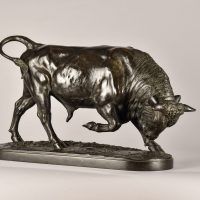






Isidore Bonheur (French, 1827-1901)
Arab with Rifle on an Arabian Mare, c. 1860
Bronze, dark brown patina
12 H. x 11 ⅜ W. x 7 ¾ D. inches
Signed on base: ISIDORE BONHEUR
Stamped on base: PEYROL







Isidore Bonheur (French, 1827-1901)
Bull With Head Down
Bronze, dark brown patina
13 ½ H. x 23 ⅜ W. x 7 ¾ D. inches
Signed on base: I. BONHEUR
Stamped on base: PEYROL
Isidore Bonheur came from a family of artists, trained by his father in painting at an early age alongside his sister, Rosa. He was born in Bordeaux, but spent most of his life in Paris. Despite being educated in painting, Bonheur had an affinity for sculpting, first exhibiting a plaster study of an African horseman being attacked by a lion in 1848 at the Salon. He regularly exhibited at the Royal Academy in London and the Salon at Paris, establishing himself as one of the greatest Animalier sculptors of the 19th century. From docile livestock to wild animal attacks and equestrian scenes, Bonheur captured each figure with the utmost sensitivity, rendering them in a highly realistic manner that characterizes the Animalier school. The majority of his works were cast at his brother in law Hippolyte Peyrol’s foundry and signed I. Bonheur; the only works cast at the foundry without a signature were early pieces from the 1840’s.
Not only did Bonheur participate in the Salon on countless occasions, but he was also awarded with medals in 1865 and 1869 for exhibiting his outstanding sculpture. Other achievements include winning the gold medal at the Paris Exposition Universalle of 1889, and the Legion of Honneur in 1895. He received a commission for two monumental bulls from the Palace of the Sultan in Constantinople in addition to commissions from King Edward VII of England and the French government. He also sculpted monuments for the Palais de Justice, the Las Delicias Zoological Park in Maracay (Venezuela), and the hôpital Sainte-Anne in Paris, to name a few.